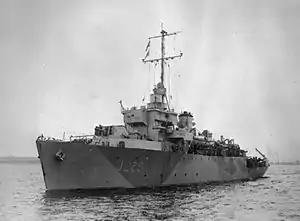HMS Cockatrice (J229)
HMS Cockatrice (J229) was a reciprocating engine-powered Algerine-class minesweeper during the Second World War.
 HMS Cockatrice | |
| History | |
|---|---|
| Name | Cockatrice |
| Namesake | Cockatrice |
| Ordered | 12 May 1941 |
| Builder | Fleming and Ferguson, Paisley |
| Laid down | 29 December 1941 |
| Launched | 27 October 1942 |
| Commissioned | 10 April 1943 |
| Decommissioned | February 1948 |
| Identification | Pennant number: J229 |
| Fate | Scrapped, 1963 |
| General characteristics | |
| Class and type | Algerine-class minesweeper |
| Displacement |
|
| Length | 225 ft (69 m) o/a |
| Beam | 35 ft 6 in (10.82 m) |
| Draught | 12.25 ft 6 in (3.89 m) |
| Installed power |
|
| Propulsion |
|
| Speed | 16.5 knots (30.6 km/h; 19.0 mph) |
| Range | 5,000 nmi (9,300 km; 5,800 mi) at 10 knots (19 km/h; 12 mph) |
| Complement | 85 |
| Armament | |
Design and description
The reciprocating group displaced 1,010–1,030 long tons (1,030–1,050 t) at standard load and 1,305–1,325 long tons (1,326–1,346 t) at deep load The ships measured 225 feet (68.6 m) long overall with a beam of 35 feet 6 inches (10.8 m). They had a draught of 12 feet 3 inches (3.7 m). The ships' complement consisted of 85 officers and ratings.[1]
The reciprocating ships had two vertical triple-expansion steam engines, each driving one shaft, using steam provided by two Admiralty three-drum boilers. The engines produced a total of 2,400 indicated horsepower (1,800 kW) and gave a maximum speed of 16.5 knots (30.6 km/h; 19.0 mph). They carried a maximum of 660 long tons (671 t) of fuel oil that gave them a range of 5,000 nautical miles (9,300 km; 5,800 mi) at 10 knots (19 km/h; 12 mph).[1]
The Algerine class was armed with a QF 4 in (102 mm) Mk V anti-aircraft gun[2] and four twin-gun mounts for Oerlikon 20 mm cannon. The latter guns were in short supply when the first ships were being completed and they often got a proportion of single mounts. By 1944, single-barrel Bofors 40 mm mounts began replacing the twin 20 mm mounts on a one for one basis. All of the ships were fitted for four throwers and two rails for depth charges.[1]
Construction and career
The ship was ordered on 15 November 1940 at the Fleming and Ferguson at Paisley, Scotland. She was laid down on 21 July 1941 and launched on 22 May 1944. The ship was commissioned on 16 October 1942.[3]
On 6 June 1944, the ship supported the invasion force during D-Day by providing smoke screens and setting up fuel lines.[4]
In February 1948, she returned to the UK and decommissioned on arrival. She was sold for scrap in 1963.
References
- Lenton, p. 261
- Chesneau, p. 65
- "HMS Cockatrice (J 229) of the Royal Navy - British Minesweeper of the Algerine class - Allied Warships of WWII - uboat.net". uboat.net. Retrieved 10 December 2021.
- "BBC - WW2 People's War - D-Day Minesweeper: Onboard HMS Cockatrice". www.bbc.co.uk. Retrieved 10 December 2021.
Bibliography
- Chesneau, Roger, ed. (1980). Conway's All the World's Fighting Ships 1922–1946. Greenwich, UK: Conway Maritime Press. ISBN 0-85177-146-7.
- Colledge, J. J.; Warlow, Ben (2006) [1969]. Ships of the Royal Navy: The Complete Record of all Fighting Ships of the Royal Navy (Rev. ed.). London: Chatham Publishing. ISBN 978-1-86176-281-8.
- Elliott, Peter (1977). Allied Escort Ships of World War II: A complete survey. London: Macdonald and Jane's. ISBN 0-356-08401-9.
- Lenton, H. T. (1998). British & Empire Warships of the Second World War. Annapolis, Maryland: Naval Institute Press. ISBN 1-55750-048-7.